CARON HOWARD and JAMES McCORMACK, Petroleum Services at Deloitte
High levels of upstream activity continue in the region, despite uncertain times due to political turmoil
 |
|
From left: Saudi Aramco’s Manifa project involves building of artificial islands to harness onshore drilling efficiencies in shallow waters. Libya’s National Transition Council soldier guards the Ras Lanouf refinery in the eastern part of the country (AP photo by Hussein Malla). Umm Slal is one of several Q-Max carriers used by Qatargas for LNG shipments.
|
|
The vast oil and gas reserves of the Middle East and North Africa (MENA) region have historically played a dominant role in the global economy, and today the region continues to be a primary exporter of oil and gas all over the world. The political turmoil of the past year has brought uncertain times to the region and fresh challenges to the oil and gas industry. Despite this, the MENA region has seen continued high levels of upstream activity, rewarded with discoveries being made and new fields coming onstream. Even with the emergence of new significant hydrocarbon plays in Brazil and Sub-Saharan Africa, the MENA region will continue playing a key role in world energy.
OIL PRODUCTION AND RESERVES
Oil has long been a major driving force behind foreign, regional and domestic interests, affecting the balance of power and territorial conflicts in the MENA region. As recent political events demonstrate, oil revenues remain key to the economies of the region. Home to eight of the 12 member countries of OPEC, the MENA region still exerts considerable control over the global energy markets.
According to the BP Statistical Review 2011, oil reserves in the MENA region in 2010 were reported to be 816 billion bbl (Fig. 1), an increase of 9% compared to the 748 billion bbl reported in 2000. The greatest growth was recorded in Qatar, where reserves have increased from 17 to 26 billion bbl, equal to 53%. This increase can be attributed to the development of several offshore fields, such as Occidental’s Al Rayyan, and Al Shaheen, operated by Maersk. Iran has also seen its oil reserves grow from 99.5 to 137 billion bbl, an increase of 37%. This can be attributed to the discovery of several fields such as National Iranian Oil Company’s (NIOC) Azadegan, Balarood and Paranj.
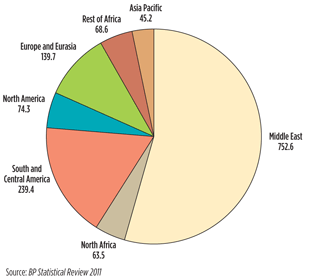 |
|
Fig. 1. Global reserves by region, billion bbl. The MENA region accounts for 63.8% of the global oil reserves.
|
|
During the same decade, oil production in the region rose to 29.5 million bpd, an increase of 7%, Fig. 2. Again, the greatest increase took place in Qatar, to 1.6 million bpd, equal to 207%, Fig. 3. This can be attributed to several fields, such as Al-Karkara, coming onstream and to the continued enhanced oil recovery efforts on older fields. In contrast, over the same period, Yemen has seen a 41% decrease in oil production, which can be explained by the natural decline of the older producing fields not being offset by new fields coming onstream.
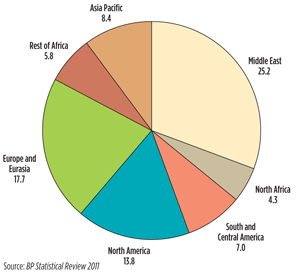 |
|
Fig. 2. Global oil production by region, million bpd. The MENA region accounts for 35.6% of the world’s oil production.
|
|
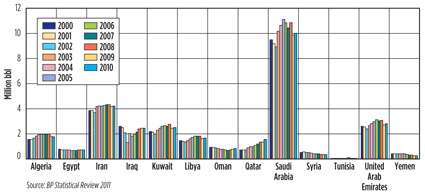 |
|
Fig. 3. MENA oil production, 2000-2010. Saudi Arabia is by far the leading oil producer.
|
|
GAS PRODUCTION AND RESERVES
For the same decade, the BP Statistical Review 2011 also reports an increase of proven gas reserves in the MENA region to 2,969 Tcf (Fig. 4), an increase of 26%. Qatar still leads with a 76% increase, due to the continued development of the giant offshore North Field, and Egypt follows with an increase of 57%. In Egypt, proven reserves, in the early 1990s stood at around 12 Tcf. By 2010, according to the Egyptian Natural Gas Holding Company (EGAS), this had risen to 78.1 Tcf. The Mediterranean offshore area currently accounts for 76% of the overall gas reserves, thanks to recent exploration campaigns, such as those by BG, BP and ENI. During the same period, gas production increased from 33 to 59.8 Bcfd, a growth of 82%. Qatar also leads in this area with a 434% increase (Fig. 5), which again can be attributed to the development of the North Field and to a number of LNG projects, such as Qatargas, coming onstream in the last ten years. Libya has also seen a 250% increase in gas production, and Egypt’s natural gas sector has expanded rapidly with production tripling between 2000 and 2010.
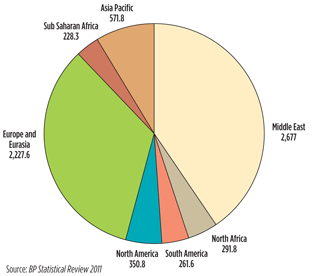 |
|
Fig. 4. Global gas reserves, Tcf. The MENA region has 44.9% of the global gas reserves.
|
|
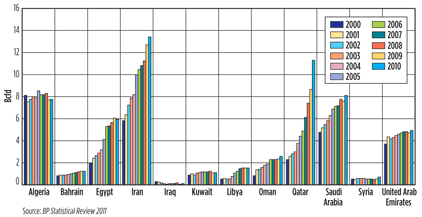 |
|
Fig. 5. MENA gas production, 2000-2010
|
|
LICENSING ROUNDS
Several countries in the MENA region launched licensing rounds in 2010, Table 1. The results have been mixed and in many instances have not yet been announced.
| Table 1. Number of rigs working offshore Brazil by type and maximum water depth, as of Aug. 31, 2011 (click table enlarge) |
|

|
Egypt. The end of 2010 saw the launch of two licensing rounds in Egypt. The first round was announced by the General Petroleum Company (GPC) in October 2010, with Exploration and Production Service Agreements on offer for five onshore blocks and two offshore blocks in the Gulf of Suez. The second round was launched by Ganoub El Wadi Petroleum Holding Company (Ganope), inviting qualified companies to bid for Production Sharing Agreements for seven onshore blocks in Southern Egypt. As of September 2011, no announcements have been made with respect to awards. At the end of the September 2011, Egyptian General Petroleum Corporation (EGPC) invited companies to bid for 15 exploration blocks in the Gulf of Suez, Sinai and Eastern and Western Deserts. A licensing round covering the Western Desert has been eagerly awaited and the round is due to close on 30 January 2012.
Jordan. Toward the end of 2010, Jordan also announced an international round. The round initially offered the North Highlands and Dead Sea blocks, and subsequently added a PSA for the East Safawi blocks in the North-East of Jordan. No awards have been made as yet.
Algeria. March 2011 saw the results of the third licensing round held by the regulatory authority, Alnaft, the ninth held in the country over recent years. Four bids were made and two licenses were awarded out of the ten on offer. CEPSA won the Rhourde Rouni II license, and Sonatrach the Rhourde Fares license. The Rhourde Rouni II license contains two discoveries and a total of 14 wells. The Rhourde Fares license contains one previous discovery and seven wells. Despite the limited success of recent licensing rounds, Alnaft is reported to be planning a further licensing round in 2011. International oil companies are hoping to see a revision of the hydrocarbon laws and an improvement of fiscal terms to encourage participation.
Oman. The Ministry of Oil and Gas launched a bid round in August 2010. The three blocks on offer are located in the central and southern regions of the country to arrest the decline in oil production. The bid round closed in October 2010 and as of August 2011 no acreage awards have been announced.
Yemen. The Ministry of Oil and Minerals in Yemen presented 10 oil and gas blocks for investment in October 2010. The Ministry received 17 applications for the 10 open blocks, but as of July 2011 no acreage awards had been announced.
Iraq. The fourth Iraq licensing round was launched in April 2011. The three previous rounds offered service contracts for the development and production of existing fields, and have been effective in increasing both oil reserves and oil production. This round includes 12 exploration blocks, close to the borders with Iran, Syria, Saudi Arabia and Jordan. The qualified companies include both winners and bidders from previous rounds. The application process will conclude with the ministry entering into contracts with the winning companies in January 2012.
Syria. September 2010 saw the closing of an onshore bid round launched by the Ministry of Petroleum and Mineral Resources alongside the General Petroleum Corporation (GPC). The round offered eight blocks under production sharing contracts and received applications from 14 international oil companies. In May 2011, HBS International was awarded Block 7, located in the east of the country close to the Iraqi border, while a Total and Suncor consortium was awarded Block 3, close to the Turkish border. As of August 2011, negotiations were still ongoing for both of these contracts. In March 2011 the Ministry and GPC launched an international offshore bid round, with three blocks on offer under production sharing contracts. This is the second Syrian offshore round; the first in 2007 attracted only one bid and saw no awards. The recent major discoveries in the eastern Mediterranean may create interest in the Syrian acreage. In June 2011 the Ministry and The General Establishment of Geology and Mineral Resources launched the International Oil Shale Exploitation Bid Round 2011 to exploit oil shale deposits in the Al-Khanaser area, 100 km south of Aleppo. 14 blocks are on offer and the closing date for applications is November 2011.
Lebanon. The first deepwater licensing round is expected in early 2012. While there are currently no concessions in this area and no wells have been drilled yet, interest in the Lebanese offshore has risen rapidly in light of the recent developments in the Eastern Mediterranean. The Lebanese government has moved rapidly to seize this opportunity and it is currently in the preliminary stages of developing its petroleum sector. The first hydrocarbon law was approved in August 2010, and work has begun on drafting a model PSA and the delineation of offshore block boundaries.
Despite the efforts of governments in the region, the most recent bidding rounds have shown that the number of awards has decreased. Delays have been common and limited information has been released after the bid rounds have closed. Nevertheless, interest is still high, with many companies seeking participation in the bidding process.
LICENSING BY DIRECT NEGOTIATION
Direct negotiation with governments, ministries and national oil companies has continued to be the favored option for awarding licenses in countries such as Israel, Tunisia and Morocco. This option has brought some new entrants to the region and has seen existing players expanding their acreage positions:
Israel. The country has seen major success in recent years with Noble Energy at the forefront of offshore exploration. Noble and partners currently own the majority of Israel’s proven offshore natural gas reserves. Next, ATP Oil and Gas entered the arena in the first of half 2011 with the acquisition of the Daniel East and West licenses and entry to the Shimshon license. As the fourth largest deepwater operator in the Gulf of Mexico, the company brings to the region significant deepwater expertise. ATP has announced planned investment of $3–5 million in 2011 for lease acquisition, seismic and data evaluation, with exploratory drilling commencing during the second quarter of 2012.
Tunisia. ETAP has continued to promote acreage on an ongoing basis and despite some political uncertainty the country remains attractive to investors. This can be attributed to a combination of factors, including the variety of opportunities, a well established industry, reasonable fiscal terms and a generally favorable business environment. Some of the most recent new entrants include New Zealand Oil and Gas (NZOG) and Repsol YPF. In June 2011, NZOG entered the Diodore permit in the Gulf of Gabes, an established productive region with nearby gas fields such as Hasdrubal and Miskar. In contrast, Repsol YPF has been awarded three previously underexplored offshore concessions. Repsol’s licenses, Ras Koran, Ras Rihane and Nadhour, are adjacent to the licenses awarded to Shell in April 2010 (Raf Raf and Azmour).
Morocco. licensing has increased significantly in recent years, with Onhym (National Bureau of Petroleum and Mines) continuing a strong campaign to promote opportunities. New licenses have been awarded onshore and offshore, and a considerable amount of acreage is still available. In July 2011, Kosmos and partners acquired an additional concession in the Agadir basin, Foum Assaka, which according to the company may hold play elements similar to those in its West Africa assets.
Libya. International oil companies flocked to the country after the lifting of sanctions, bringing significant investments in exploration projects and mature producing assets. Some believe that the recent exploration efforts have failed to live up to initial expectations, with a disappointingly low number of discoveries and slow progress with major field developments. Even prior to the current civil war, several major companies, including Chevron and Occidental, who were among the first international players to invest after the sanctions were lifted, as well as Woodside and Liwa Energy, had reportedly elected not to extended their five-year licenses and were preparing to exit the country. BG had already announced that it was in the process of relinquishing its rights after drilling three dry wells. While the initial momentum may appear to have been lost, the country remains largely under-explored and interest may be re-ignited by new, more favorable circumstances in the future.
Qatar. JX Nippon Oil and Gas Exploration Corporation and Qatar Petroleum signed a 30-year Exploration and Production Sharing Agreement (EPSA) for offshore Block A. This is the third deal Qatar Petroleum has signed to explore for oil and gas in the deep pre-Khuff reservoirs. This contract is part of Qatar Petroleum’s plans to increase its hydrocarbon reserves and production whilst a moratorium on the further development of the North Field is in place until all the planned gas projects have been brought on stream until 2013 or later.
EXPLORATION DRILLING
North Africa has seen high levels of exploration drilling activity in the past few years. The breakdown by country is shown in Table 2.
| TABLE 2. ANNOUNCED EXPLORATION DRILLING (click table enlarge) |
|
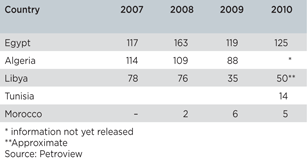
|
Egypt leads with over 100 exploration wells drilled a year, placing it ahead of its neighbors. Early in 2011, the Ministry announced that it expected 350 new exploration wells to be drilled this year. Whether this is achievable remains to be seen, but in the first five months of the year approximately 50 new exploration wells have been drilled. The high levels of exploration drilling activity can be attributed to the increasing number of players who are currently exploring basins across the country.
High numbers of exploration wells have also been drilled in Algeria, following closely behind Egypt. While much of the drilling is undertaken by foreign players, the national oil company, Sonatrach, also carries out extensive drilling campaigns. Libya has also seen considerable exploration drilling activity particularly during 2007 and 2008, when over 60 wells were drilled annually. In 2010, approximately 50 new exploration wells were drilled across the country. In contrast, Tunisia has experienced much lower levels of exploration drilling, with 14 exploration wells reportedly drilled in 2010. Morocco has seen the least new exploration wells, but activity is expected to increase in light of the large number of acreage awards and related future drilling plans.
In the Middle East, a large number of exploration wells have been drilled in the past year. In Saudi Arabia, 44 exploration wells were drilled, a significant increase from the 26 of the previous year. In 2009, Saudi Aramco drilled a far greater number of development wells.
In Oman, 37 exploration wells were drilled by the Petroleum Development Oman (PDO) in 2010, a considerable increase on the 21 drilled in 2009. Similar to Saudi Aramco, PDO also drilled more development wells in 2009 compared to 2010. Much lower levels of exploration activity are observed in other Middle Eastern countries such as Bahrain, Qatar, Jordan and Kuwait, where drilling is focused on maintaining production through development and injection wells.
The Eastern Mediterranean is fast becoming an exploration hotspot, with offshore drilling continuing in Egypt and in Israel. The first commercially viable field in Israeli waters, Mari-B, was discovered in 2000, and gas is sold to the Israel Electricity Corporation for power generation and refining. In 2010, average daily production was reported at 330 MMcfd from six wells. In recent years, however, sustained exploration efforts by Noble Energy and partners have dramatically changed Israel’s oil and gas prospectivity, with the three major discoveries of Tamar, Dalit and Leviathan.
In Iraq, Kurdistan has seen high levels of activity leading to the discovery of many new fields. Rapid advancement in seismic technology has been helpful, particularly in geologically unstable areas like the Zagros fold belt. Companies operating in Kurdistan have found substantial oil and gas fields such as Tawke, discovered by DNO, and Kurdamir and Sarqala, discovered by WesternZagros Resources.
In Oman, Consolidated Contractors, Tethys Oil and Mitsui have continued to explore and appraise the Saiwan East and Farha South fields in Blocks 3 and 4. The successes in the Barik and Al Bashir Formations in the Farha South field and the Khufai Formation in the Saiwan East field have opened up a new play to the east of the established oil and gas province in PDO’s Block 6. The fields are currently undergoing extended test production, with the aim to optimize future production volumes. Production is currently trucked to the Alam station, 80 km away where it is pumped into the oil network. Consolidated Contractors has submitted a field development plan for both Saiwan East and Farha South, which is currently being evaluated by the Ministry of Oil and Gas.
In North Africa, there are a number of frontier areas where exploration is anticipated. Prior to the unrest, interest in BP’s planned drilling campaign offshore Libya was high. The company was due to drill five wells in the Gulf of Sirte. The campaign, BP’s first deepwater drilling project in the country, had already faced numerous delays following the Deepwater Horizon incident and is currently on hold. In Algeria, Sonatrach announced in March 2011 that offshore exploration activities would commence with the acquisition of 5,000 square km of 2D seismic. In Morocco, following their first offshore discovery of Anchois-1 in 2009, Repsol YPF and partners are due to carry out further offshore drilling.
Exploration continues apace in Upper Egypt with campaigns such as that of Energean in the West Komombo concession, where the WKO-1X and WKO-3X wells were drilled in the first half of this year. This is an area of sparse geological and geophysical data coverage but interest in the area was renewed with the Centurion Energy/Dana Gas, Al Baraka oil discovery in the Komombo Block in 2007.
DISCOVERIES
In North Africa, Egypt has consistently scored the highest number of discoveries since 2008, with an exceptional 40 discoveries in 2010, Table 3. A large proportion of these are located in the Western Desert and Nile Delta regions.
| TABLE 3. ANNOUNCED DISCOVERIES (click table enlarge) |
|
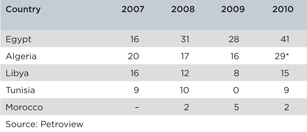
|
Algeria. Sonatrach announced 29 discoveries in 2010, although associated information has been minimal. GazProm made its first commercial gas find outside of Russia with Rhourde Saya-2 on the El Assel license, and E.ON Ruhrgas made the Zemlet Cherguia-1 extension discovery in the Rhourde Yacoub block. Both of these wells were drilled in the prolific Berkine Basin. In the first six months of 2011 no discoveries were announced by Sonatrach. Libya had 15 discoveries in 2010, almost double the number in 2009.
Libya. Turkish Petroleum Overseas Company (TPAO) made a succession of discoveries in Area 147-4 in the Murzuq basin in Libya. Prior to the current political turmoil, 10 exploration wells were drilled resulting in seven oil discoveries. In Morocco, Circle Oil continues with successful activity in the Sebou Permit: 11 exploration wells have resulted in 10 discoveries, and further exploration and development is ongoing. The drilling program was delayed by flooding in 2010 but the KAB-1 and CGD-11 wells both observed significant gas shows. In 2011 it was confirmed that the KSR-11 and ADD-1 exploration wells also discovered gas, testing from the Miocene.
Tunisia. OMV made four gas-condensate discoveries in the Nawara concession raising the success rate to nine consecutive hits. This drilling campaign proved enough resources to justify the start of the South Tunisian Gas Pipeline (STGP) project.
Egypt. Gas discoveries have continued in the offshore Mediterranean in deeper and more technically challenging high pressure and high temperature conditions. Following Raven (2004) and Satis (2008), which illustrated the potential of deeper reservoirs, BP made the Hodoa discovery in the deepwater West Nile Delta area. Significantly, this was the first deepwater Oligocene discovery encountering a 20-m productive interval. It drilled to a total depth of 6,350 m in a water depth of 1,077 m and it has estimated reserves of 600 Bcf of gas and 17 MMbbl of condensate.
The Western Desert has also continued to be a focal point of success with Apache playing a dominant role. In 2010, the company made 10 new field discoveries and in the first six months of 2011 it added eight new discoveries in the Faghur basin alone, with more drilling underway. The success illustrates the multi pay potential of the area, with Palaeozoic reservoirs now proven alongside the already established Cretaceous Alam el Buib Formation and Jurassic Safa Formation. In the Nile Delta, Dana Gas drilled 11 exploration wells and was rewarded with seven new field discoveries including West Ward Delta and Abu El Naga South.
The Eastern Desert has continued to prove itself, with further discoveries made by Vegas Oil and Dana Petroleum. Vegas Oil made an oil discovery with the Al Ola-1X well, close to its producing Al Amir South East field, discovered in 2008. Dana Petroleum, which operates the contiguous North Zeit Bay concession, has also made two oil discoveries in close proximity to Al Amir South East with the Lorcan-1X and Fin-1X wells.
Israel. The most well documented and highly publicized discovery of the year is Noble Energy’s Leviathan, offshore Israel. Leviathan is the largest discovery in the company’s history and, with an estimated 16 Tcf of natural gas, the find further confirms the potential of the Eastern Mediterranean. After the discovery of Tamar (8 Tcf) in 2009, for the second consecutive year Noble’s gas discoveries in Israel have rated among the top 10 worldwide. Leviathan is currently presenting some challenges after all three wells drilled so far experienced problems and had to be suspended.
Iraq. In Kurdistan, Heritage Oil announced the discovery of a large gas field with the Miran West-2 appraisal well, which tested 75 MMcfd from a Jurassic reservoir. The well was a follow-up to the Miran West-1 well, drilled by Heritage early in 2009, which tested over 3,600 bpd from a Cretaceous interval. Following the completion of the latest well, P50 reserve estimates for the Miran West field have been increased to 6.8 Tcf. Heritage will proceed to drill a third well on the Miran field, with a second rig being introduced in the third quarter of this year to further appraise the structure. Development options are currently being evaluated, with initial priority given to domestic supply by 2013. Subsequent plans include export to Europe via the Nabucco pipeline by 2015.
Middle East. The greatest numbers of discoveries in 2010 have been in Iran. The country’s eight discoveries include the National Iranian Oil Company’s Bid Zard oil field and the Toos gas field. Elsewhere there were numerous discoveries in Iraq, Saudi Arabia, Oman and Yemen, where notably Sinopec discovered the Judayaah oil and gas field in Block 71. In Saudi Arabia, Saudi Aramco discovered four oil fields, Namlen, As Sayd, Arsan and Qamran and one gas field, Jalamid, which tested 12.1 MMcfd from the Sarah reservoir. In Oman, PDO discovered four oil fields, Sayyah, Al Ghubar East, Aqeeq and Amal Southeast, with a total of 800 MMbbl in place; and one gas field, Khulud West.
DEVELOPMENTS
Many development projects have focused on bringing new gas reserves onstream. The region is experiencing increasing domestic gas demand from desalinization plants, power plants and petrochemical industries, and therefore, needs to boost its gas production.
Israel. The Infrastructure Ministry recently authorized Noble to begin the development of the Noa North natural gas field. With Mari-B set to decline sharply, Tamar not due onstream until 2013 and the uncertainties of Egyptian gas supply, the development plan was approved in July. With Israel’s large internal energy requirements and growing domestic demand, bringing Noa North onstream will help to ensure continuity in supply.
Algeria. Anadarko’s El Merk gas project is approximately 65% complete and the construction of processing facilities and infrastructure continues apace. Initial production is scheduled for 2012 and will increase gradually until the facilities are completed. First gas from the Timimoun project is still expected in late 2013 with peak commercial production rates of approximately 160 MMcfd. Repsol YPF, Edison and RWE received approval for the development plans of the Reggane North field, in the Reggane Basin, with an estimated capacity of 3 Bcf per year. Petroceltic also aims to submit a development plan for the discoveries on the Isarene permit by early 2012.
Egypt. BP, RWE and EGPC signed an agreement for a $9 billion gas field development project in the offshore West Nile Delta. The fields (Giza, Taurus, Libra, Fayoum, Ruby and Raven) are located in the North Alexandria and West Med deepwater concessions with combined gas reserves estimated at 5 Tcf. The project is due to deliver first gas in 2014, and during the following year, output is expected to reach 1 Bcfd. RWE has committed $3.6 billion to the project, which represents the largest single investment in the company’s history.
Oman. BP signed an exploration and production sharing agreement with the Oman government in 2007 to appraise and develop the Khazzan and Makarem gas fields in Block 61. BP has used the expertise developed in North America to develop the tight gas reservoirs by using fracture stimulation to double flow rates. Gas from the appraisal wells is now flowing to an extended well testing facility and into a compressor station. Once compressed, the gas runs through export lines to a PDO facility, ready for the domestic market. Five more wells are to be tied into the extended well testing facility this year and will help to ascertain the potential of the two fields. If the project is deemed commercially viable, full field development will go ahead with the potential to come onstream in 2016 and to produce 1 Bcfd of gas.
Oman Oil Company Exploration and Production LLC (OOCEP) is due to develop the Abu Butabul field after acquiring Block 60 in March 2011. The company has pledged to invest $1.1 billion for the first phase of development, which will target the southern portion of the field. Initial production is planned for 2013, and peak production is expected to reach 90 MMcfd. The second phase will concentrate on the northern portion of the field with production ramping up to 140 MMcfd. OOCEP will put in place gathering systems, flowlines, wells, a gas processing station, a compression station and a pipeline to export the gas to the PDO-operated Barik station, 85 km away.
Qatar. The year 2010 also saw the start of operations of the Qatargas 3 and Qatargas 4 projects. The Qatargas 3 project involved the construction of a new LNG train 6, with a capacity of 7.8 MMtpa . Production started in November 2010 and will produce 1 Bcfd for 25 years. Qatargas 4 saw the construction of a new LNG train 7, with a similar capacity to Qatargas 3, for export markets.
DEAL ACTIVITY
Deal activity in the MENA region has decreased in 2010 compared to 2009. Many of the deals see already established companies expanding their portfolios in North Africa. In 2011, one of the most notable transactions was OMV’s purchase of Pioneer Natural Resources’ Tunisian E&P business for $800 million, plus $39.3 million working capital. OMV, already a prominent and successful player in Southern Tunisia, gained both acreage with the Anaguid exploration permit, and production with the Mona/Durra concession, which complement its existing assets of Jenein Sud and Nawara. The transaction has doubled OMV’s daily production to more than 10,000 bpd.
In 2011, ENI committed to additional exploration and development activities in the Mediterranean, the Sinai and the Western Desert of Egypt. Plans include ramping up production from new discoveries with further development work and a 12-well exploration campaign. Investment amounts to approximately $3 billion and includes a budget for training and community activities.
In November 2010, Apache concluded the purchase on BP’s assets in the Western Desert of Egypt, acquiring four development leases and one exploration concession, as well as strategically positioned infrastructure. This transaction will enable Apache to increase production from their existing fields in the Western Desert. Early in 2011, BP announced the sale of its Algerian assets, attracting interest from TNK-BP, but the plan was later withdrawn. BP is still expected to spend $2 billion in Algeria over the next five years.
RAK Petroleum Public Company Limited has signed a heads of agreement to merge RAK Petroleum and its subsidiaries with DNO in exchange for a 10% increase its current shares in the company. On closing, it is expected RAK Petroleum will hold a 40% interest in DNO. RAK Petroleum has assets in Tunisia, Oman and the UAE, whilst DNO has assets in Equatorial Guinea, Yemen, Iraq and the United Kingdom.
In August 2010, RWE and the Kurdistan Regional Government signed a gas cooperation agreement to design and develop a domestic gas transport infrastructure system with the potential to export gas to Europe via the Nabucco pipeline. However, the legality of the contract has been disputed by the Iraqi Oil Ministry, which expects all contracts and agreements to be signed with the State Oil Marketing Organization.
FARM-IN ACTIVITY
In 2010 and 2011, farm-in opportunities have increased in Morocco, Tunisia and Egypt, as companies look to share risk. Recent examples in Egypt include MENA Hydrocarbons looking to take a 55% interest and operatorship from Hess in the West Med Block 1, and TransGlobe Energy acquiring 50% in South Alamein from Cepsa.
In other countries, such as Algeria, farm-in opportunities are rare with new acreage most often awarded via licensing rounds. A recent exception was Petroceltic’s sale of an 18.375% interest in the Isarene license to Enel. This has been a successful permit for Petroceltic and it includes the 6.1 Tcf Ain Tsila gas condensate discovery. Enel is not new to the industry in Algeria, as a main consumer of Algerian gas, and also a partner in both the Medgas and Galsi Trans Mediterranean pipelines. This deal, however, represents Enel’s entrance in the country’s upstream arena. The deal provides Petroceltic with support in the ongoing appraisal campaign and future development planning.
In the Middle East, there are still numerous opportunities to farm into acreage positions, for instance in Yemen, but the amount of companies taking up this acreage has decreased. This could be attributed to the quality of acreage and/or the political situation in some of the countries.
In Iraq, Marathon Oil farmed into the Atrush license with a 20% interest with Shamaran Petroleum and Aspect Energy, and participated in the Atrush-1 well discovery. The company also farmed into the Sarsang licenses with Hillwood Energy Company, with a 25% interest.
Also in Iraq, Afren farmed into the Barda Rash permit in July 2011, securing a 60% operated interest. The block was previously operated by the Komet Group, which discovered the Barda Rash field. Afren also secured a 20% participating interest in the Ain Sifni permit, operated by Hunt Oil.
UPCOMING E&P ACTIVITIES
In the next 12 months, we expect that developments in both Federal Iraq and the Kurdistan region will be a focus of activity in the Middle East. Iraq is home to significant hydrocarbon reserves, but has historically lacked the financial resources and infrastructure to develop them. In Federal Iraq, production is forecast to increase as a result of the contracts awarded in the first two licensing rounds, as the winning consortiums continue development work. In January 2012, exploration service contracts are due to be awarded, and it will be interesting to see how the model exploration contracts are structured. In Kurdistan, with many companies scheduled to drill wildcat wells, we will also see if the high initial success rate can be sustained, and whether the resumption of oil exports will lead to the fast tracking of fields into production to satisfy both domestic and international markets.
In the Eastern Mediterranean region, the recent spectacular discoveries offshore Israel, supported by USGS studies attributing world class potential to the Nile Delta and Levant basins, have transformed the region into one of the hottest exploration plays. With the frontier offshore areas of Lebanon and Syria opening up, the groundwork is being laid to establish an offshore Eastern Mediterranean upstream industry. The region seems set to remain a focus of activity as licensing and exploration commences in the frontier areas and development projects move ahead.
Egypt continues to be a hotspot attracting large numbers of international companies to invest in all areas, from its Mediterranean waters to the mature fields of the Gulf of Suez. Despite the political uncertainty, companies have continued to display their commitment in the first half of 2011 by signing new deals and expanding their acreage. The country has retained a strong reputation for its variety of opportunities, ensuring it remains high on the new ventures agenda for companies of all sizes. Recently, the Minister of Petroleum announced that the country is planning to invest $1 billion in the Sinai Peninsula, drilling 60 new wells in order to increase Egypt’s strategic reserves. As in many other parts of the world, unconventional exploration has also started, with Apache drilling deeper in their acreage in the Western Desert.
In conclusion, over the past year the business risk perception of the MENA region has been impacted by political events of great importance. While uncertainty and risk cannot be ignored, many parts of the region are still relatively under-explored and substantial opportunities remain. Many of the major international oil companies have substantial shares of their reserves and production in this region and are expected to continue investing heavily in the area. There is still much oil to be produced and significant potential for new discoveries for the future. With the emergence of new gas provinces such as the Eastern Mediterranean, the MENA region is set to remain attractive for years to come. 
|
THE AUTHORS
|
|
CARON HOWARD is the North Africa and Mediterranean Team Leader for Deloitte Petroleum Services in London. She has been with Petroleum Services since 2006, focusing on the development of the information services for the region. Before joining Deloitte, Ms. Howard worked in the Middle East Business Unit at BP as a Geological Technical Assistant. She graduated from Royal Holloway, University of London, with an MSci in Geoscience in 2003. / carhoward@deloitte.co.uk
|
| |
| JAMES McCORMACK is Middle East Team Leader for Deloitte Petroleum Services in London. Mr. McCormack is responsible for the development and maintenance of PetroView Middle East, a database of oil and gas assets GIS tools. He joined Deloitte in 2007 after completing a master’s degree in Geology from Southampton University. / jmccormack@deloitte.co.uk. |
|











